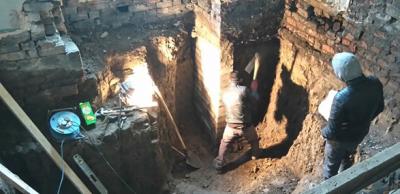How to get it right: Building control exemptions (or when you DON'T need building regulations approval)
While we love to be involved, there are times when you won’t need a Building Regulations application. Whether you are carrying out building work yourself, or employing a builder, there are a number of building regulations exemptions to both work and buildings that don't need building control approval.
The following is intended as a guide but you should always check with your local LABC team if you're in any doubt or need clarification. You can also view Planning Portal’s interactive guides for more information.
Remember, these exemptions only relate to building control applications and you may need to apply for planning permission separately, particularly if you live in, or are carrying out work, to a property that is listed or within a conservation area.
Work that does not need building control approval
- Maintenance work
- Minor repairs
- Replacing less than 25 per cent of an item, like-for-like
- Additional power or lighting points and switches (except around baths and showers)
- Alterations to existing circuits (except around baths and showers)
- Like-for-like replacements of baths, toilets, basins or sinks
- Boundary or garden walls, fences and gates
- In some cases, works that are being carried out by competent registered persons (check details for this with your local LABC team)
Buildings that do not need building control approval
- Greenhouses (providing they are not used for retail, packing or exhibiting)
- Some agricultural buildings (check with your local LABC team)
- Temporary buildings (erected for less than 28 days)
- Some ancillary buildings such as estate sales buildings and building site offices without sleeping accommodation
- Some small detached buildings (check with your local LABC team)
- Buildings that are not frequented by people (check with your local LABC team)
- Detached single storey buildings, including garages, that are less than 30m2 floor area and contain no sleeping accommodation, and are at least one metre from any boundary or constructed of non-combustible materials
- Detached single storey buildings that are less than 15m2 floor area
- An extension to a building at ground level consisting of a porch of less than 30m2 floor area and separated from the house by an external type door
- A carport open on at least two sides
- A covered yard or covered way less than 30m2
- A conservatory or porch that is less than 30m2, with a significant proportion of the roof and walls glazed (no % given), it must be at ground level, it must comply with relevant sections of Part K (glazing), be thermally separated from the dwelling by external quality windows and/or doors and the buildings heating system must not be extended into the conservatory or porch.
- Crown property
- Buildings subject to the Explosives Act
- Buildings other than houses or offices erected on a site licensed under the Nuclear Installations Act
- Buildings included in the Schedule to Section 1 of the Ancients Monuments and Archaeological Areas Act
Don’t forget that you might still need approval for any enabling works. For example creating a wider opening into an exempt conservatory would still need approval for the structural alteration to widen the opening.
Further information
For further guidance on getting building control approval visit the Planning Portal’s free guide.
Please Note: Every care was taken to ensure the information was correct at the time of publication. Any written guidance provided does not replace the user’s professional judgement. It is the responsibility of the dutyholder or person carrying out the work to ensure compliance with relevant building regulations or applicable technical standards.
Sign up to the building bulletin newsletter
Over 48,000 construction professionals have already signed up for the LABC Building Bulletin.
Join them and receive useful tips, practical technical information and industry news by email once every 6 weeks.
Subscribe to the Building Bulletin





Comments
Space above a Garage
Submitted 4 years 1 month ago
(No subject)
Submitted 4 years ago
You can find their contact details by using the postcode search in the top righthand corner of this page.
Best,
LABC team
Classroom
Submitted 3 years 9 months ago
I have a client that requires a detached classroom on the grounds of a school.
This classroom will have wash and toilet facilities.
The client is under the impression we do not need building regulations.
As far as I know the build will not exceed 30sqm and will be sited more than 1m away from boundaries, so in some respect it would be exempt however due to it having wc facility I am convinced it may need building control sign off on the whole build.
Could you shed any light on the subject?
Thanks Chris
LABC response
Submitted 3 years 9 months ago
Thank you for your recent enquiry regarding a detached classroom in the grounds of a school. If the building is as you have indicated then it appears that it would fall within the exemptions given under building regulation 9 and Class 6 of Schedule 2.
(See links: https://www.legislation.gov.uk/uksi/2010/2214/regulation/9 & https://www.legislation.gov.uk/uksi/2010/2214/schedule/2)
Regulation 9(1)(b) refers to the carrying of any work to or in connection with an exempt building also being exempt so long as the exempt building remains as that described in Class 6 of Schedule 2 after any such work has been completed.
A small, detached building exempt by reg 9(1)(a) and (b) and being in Class 6 of Schedule 2 may require the provision of any cold or hot water to be controlled, where that water is received from a source shared with or located inside any other building other than from another exempt building – in which case Requirements G1 and G3(2) and (3) of Schedule 2 will apply. As such the requirements of G1 and G3(2) and (3) might have to be satisfied because of the provision of a WC.
The requirements of Part P only apply to buildings that are dwellings or contain dwellings – as such Reg 9(3) does not appear to apply.
If the new classroom is provided with its own WC then the drainage serving the WC will also be exempt so long as it does not connect to any drainage system serving another existing (non-exempt) building. In which case, if it does, the drainage would also be controlled under requirements H1, H3 and H5, as a result of there being an extension of a controlled service or fitting
If the classroom building is to be built over a sewer (one that is shown on the water companies map of sewers) – and yet remains exempt because of building regulation 9(1)(a) and Schedule 2 Class 6 – it would be necessary for the person carrying out the work to contact the sewer undertaker to enter into a possible building over agreement for the siting of the classroom block.
Given the suggested size of the classroom block, had it not been exempt from all the applicable requirements of the building regulations, it might have still been exempt from the energy efficiency requirements contained in Part 6 of the Regulations and requirement L1 of Schedule 1, because of the exemption given under building regulation 21(2)(c) and 21(3)(d) – stand alone buildings other than dwellings with a total useful floor area of less than 50sqm.
As a consequence, any single storey building that has internal floor area not exceeding 30sqm, contains no sleeping accommodation, and is situated at least 1m or more from the boundary of its curtilage, is exempt from all the requirements contained in the building regulations.
Only the work relating to the provision of hot and cold water might be controlled if the water is shared with/comes from another non-exempt building and any work to extend an existing foul or surface water drain would be controlled. In these circumstances only these aspects of the work need to be notified to the local authority and should comply with the applicable parts of the building regulations – Parts G and H.
Notwithstanding that the classroom block itself might be exempt (hot/cold water supply and drainage aside) the building should be designed and constructed having due regard to any health, safety, welfare, convenience and access obligations that might otherwise need to be applied – regardless of building regulations. Similarly, the requirements of the client should also be taken into consideration and in every case due diligence should always be applied.
Best,
LABC team
Building Regs
Submitted 3 years 9 months ago
We were granted planning permission for a singe storey extension to replace our old conservatory. However, due to the cost of an extension, we decided to replace the old conservatory with a new Warmroof conservatory. Unfortunately we were unhappy with the workmanship and this led to a dispute with the supplier, which resulted in the complaint being escalated through the ADR process. An independent surveyor’s report has raised the issue of Building Regulations, which we were advised by the supplier as not required. The conservatory is constructed of two glazed walls and one block wall, with a Warmroof with two roof lights (windows). Please can you clarify if Building Regs are required or not?
LABC response
Submitted 3 years 8 months ago
Thank you for your recent enquiry regarding whether a conservatory extension is exempt from the building regulations or not.
We have noted your comments and would strongly advise that the matter be discussed with your local councils' building control section, as they are the enforcing authority for the Building Regulations.
It will be your local council, and not LABC, who will need to decide whether the work is controlled or not and they may have to inspect the conservatory in order to better determine this.
Best,
LABC team
Orangery
Submitted 3 years 8 months ago
It will also be timber frame building with a brick facade so the structure will be timber frame insulated with plasterboard.
Does this need any sort of building control?
LABC response
Submitted 3 years 7 months ago
Thank you for your recent enquiry, from the information you have provided it appears that the orangery/conservatory may be exempt from building regulations as it is less than 30m2 internal floor area. The building regulations also require that the conservatory is separated from the existing house by external quality doors/windows. The electrical work would need to be carried out by a competent electrician as out lined in the competent person’s scheme.
I would also clarify that LABC is a member organisation and can therefore only provide general advice. The LA where you live can provide project specific advice.
Best,
LABC team
cladding top half of house
Submitted 3 years 8 months ago
LABC response
Submitted 3 years 7 months ago
Thank you for your enquiry. Where a new cladding layer or replacement of an existing is proposed, the work might be a ‘renovation of a thermal element’ and require building regulations approval. However, there are particular rules for the application of the requirement, and we suggest taking specialist advice or consulting with the building control team at your local authority to discuss specific requirements.
The colour of the cladding is not a building regulation issue, but you may need planning consent. Please contact your local planning authority for information.
You can find the contact details of the relevant local authority for planning or building regulations by entering your postcode in the search box of the government website ‘Find your local council’: https://www.gov.uk/find-local-council
Best,
LABC team
Add new comment